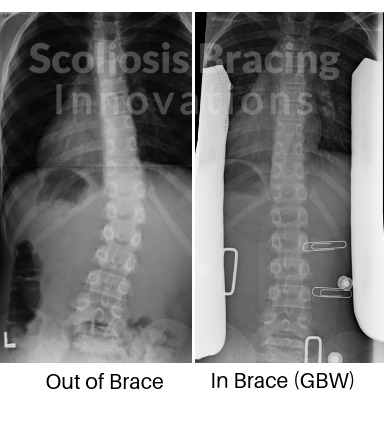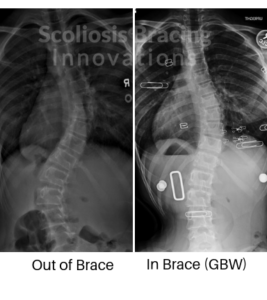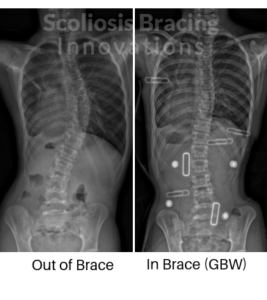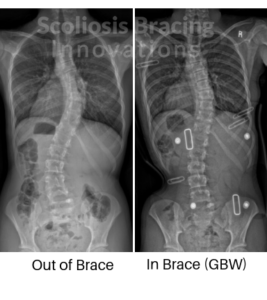When working toward non-surgical scoliosis correction, asymmetric bracing has been shown to be more effective than symmetric scoliosis braces (1). The 3D Cheneau Gensingen Brace™ (aka GBW) is specifically designed to positively influence the spine toward the normal physiologic position and allow for improved longitudinal growth. Simply stated, this is accomplished by reducing asymmetric loading to induce the greatest possible in-brace correction.
To achieve this goal, each Gensingen scoliosis correction brace attempts to remove the compressive forces that inhibit growth in the scoliotic spine. This is in accordance with the Hueter-Volkmann principle which states that skeletal growth is reduced by increased compressive forces (in scoliosis, the concave side) and accelerated on the opposing side (in scoliosis, the convex side) as a result of the reduced mechanical compressive forces. According to Stokes, “sustained compression” inhibits growth by 40% or more while distraction on the opposing side increases the skeletal growth rate. He refers to this phenomenon as mechanical loading or asymmetric loading.
The Gensingen Brace™ is designed to help induce scoliosis correction. It does so by working synergistically to reduce the compressive forces of scoliosis in the frontal, sagittal and transverse planes, thereby reducing asymmetric loading during growth to improve spinal alignment.
This means that the patient has an improved chance of longitudinal growth and stabilization or even for scoliosis correction. From a physical and radiological standpoint, goals are to cosmetically improve posture, spinal balance and Cobb angle measurement, whenever possible. One way the Gensingen Brace™ works to achieve this is by incorporating pressure zones over the convexities with opposing voids over the concavities. This allows for corrective movement so Schroth breathing (corrective, derotational breathing) can occur while the patient wears the brace. While these are the stated principles of other Cheneau braces, not all braces succeed in attaining this goal.
Each Cheneau Gensingen Brace™ is manufactured from a 3D scan of the patient’s body. The built-in scoliosis correction effect comes from the brace design which is a mirror image of the patients’ scoliotic curve pattern. During brace fittings, practitioners focus on adjusting the brace for comfort and optimal pad positioning to enhance the built-in correction effect.
In-brace correction is of utmost importance to the result at the conclusion of brace wear. Landauer et. al correlated an in-brace correction effect of 40% to a reduction in thoracic Cobb angle of 7º. It stands to reason that the greater the in-brace correction, the more potential for some extent of scoliosis correction at skeletal maturity (3).
The Cheneau Gensingen Brace™ has documented impressive in-brace corrections (4). However, practitioners should know that the potential for scoliosis correction will vary by patient (spinal flexibility, type of scoliosis, compliance) and practitioner brace management (proper adjustment and replacement). Generally, less skeletally mature patients with more flexible spines are more likely to experience better in-brace corrections. However, the Cheneau Gensingen has been used successfully for patients with varying Cobb angles and stages of skeletal maturity.
(1) Ng SY, Borysov M, Moramarco M, Nan XF, Weiss HR. Bracing Scoliosis – State of the Art Mini Review. Current Pediatric Reviews 2016;12(36-42).
(2) Stokes, IAF, Mechanical effects on skeletal growth. J Musculoskel Neuron Interact 2000;2(3):277-280.
(3)Landauer F, Wimmer C, Behensky H. Estimating the final outcome of brace treatment for idiopathic thoracic scoliosis at 6-month follow-up. Pediatric Rehab 2003; 6(3-4):201-7.
(4) Weiss HR, Seidel S, Moramarco M, Kleban A. Bracing Scoliosis: The evolution to CAD/CAM for improved in-brace corrections. Hard Tissue 2013; 2(5):43.










